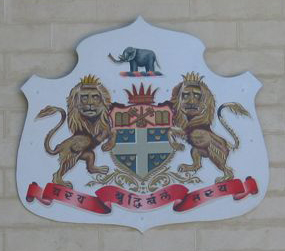
Nawab, also spelt Nawaab, Navaab, Navab, Nowab, Nabob, Nawaabshah, Nawabshah or Nobab, is a Royal title indicating a sovereign ruler, often of a South Asian state, in many ways comparable to the western titles of King. The relationship of a Nawab to the Emperor of India has been compared to that of the Kings of Saxony to the German Emperor. In earlier times the title was ratified and bestowed by the reigning Mughal emperor to semi-autonomous Muslim rulers of subdivisions or princely states in the Indian subcontinent loyal to the Mughal Empire i.e. Nawabs of Bengal. The title is common among Muslim rulers of South Asia as an equivalent to the title Maharaja, however it is not exclusive to Muslims only.

The Rajkumar College in Rajkot, Gujarat is one of the oldest K-12 institutions in India. RKC has a 26-acre campus in Rajkot.

Sahib or Saheb is a word of Arabic origin meaning "companion". As a loanword, it has passed into several languages, including Persian, Kurdish, Turkish, Kazakh, Uzbek, Turkmen, Tajik, Crimean Tatar, Urdu, Hindi, Punjabi, Pashto, Bengali, Gujarati, Marathi, Rohingya and Somali. It can be used as a term of address, either as an official title or an honorific. It is often shortened to saab.
Begum Noor Bano served as a Member of Parliament in the 11th Lok Sabha and 13th Lok Sabha, lower house of parliament of India. She was elected from Rampur on the ticket of Indian National Congress party.

The Nawab of Banganapalle was the leader of Banganapalle, a fief of the Mughal empire which later became a princely state of British India, before being incorporated into Kurnool district of the Madras Presidency.

The Imperial Legislative Council was a legislature for British India from 1861 to 1947. It succeeded the Council of the Governor-General of India, and was succeeded by the Constituent Assembly of India and after 1950, was succeeded by Parliament of India.

Rampur State was a 15 gun-salute princely state of British India. It came into existence on 7 October 1774 as a result of a treaty with Oudh. Following independence in 1947, Rampur State and other princely states of the area, such as Benares and Tehri Garhwal were merged into the United Provinces. Rampur state had its capital in Rampur city and its total area was 945 sq miles.

Sayyid Mubarak Ali Khan II, popularly known as Humayun Jah, was born on 29 September 1810 to Ahmad Ali Khan and Nazib un-Nisa Begum. He was the Nawab of Bengal from 1824 to 1838. He was succeeded by Mansur Ali Khan. He built the famous and renowned Hazarduari Palace and Mubarak Manzil in Murshidabad. Nawab Nazim Humayun Jah died on 3 October 1838.
Nawab Sayyid Murtaza Ali Khan Bahadur, MBE was the titular Nawab of Rampur from 1966 to his death in 1982, succeeding his father, Nawab Raza Ali Khan Bahadur. Murtaza was succeeded by his younger brother Zulfikar Ali Khan Bahadur.

Wali Kirani was a Muslim saint. His date of birth and date of death are not known, but is believed to have lived around the time of Sultan Hussain Mirza's rule in Herat around 1470.
Major Nawab Sayyid Zulfikar Ali Khan Bahadur was an Indian politician and an Indian army officer who ruled as Titular Nawab of Rampur from 1982 to 1992, succeeding his elder brother Murtaza Ali Khan Bahadur.
The Khadem are a Muslim community found in the state of Rajasthan in India, and in Pakistan..

Jaora State was a 13 gun-salute princely state of the British Raj. It was part of the Malwa Agency.

The princely states of Pakistan were former princely states of the British Indian Empire which acceded to the new Dominion of Pakistan between 1947 and 1948, following the Partition of (British) India and its independence.

Cambay, Kambay or Khambhat, was a princely state during the British Raj. The City of Khambat (Cambay) in present-day Gujarat was its capital. The state was bounded in the north by the Kaira district and in the south by the Gulf of Cambay.

Sayyid ul Sadaat Khwaja Sayyid Mir Khawand Mahmud ibn Sharif Naqshbandi al-Hasani wal-Husseini, known as "Hazrat Ishaan Shah Saheb" is a Sufi Saint from Bukhara, Uzbekistan.

Sayyid ul Sadaat Mir Sayyid Mahmud Saheb Agha al-Hasani wal-Husseini was a Sufi saint and direct descendant of the Islamic prophet Muhammad. He was the brother of Sayyid Mir Jan.










